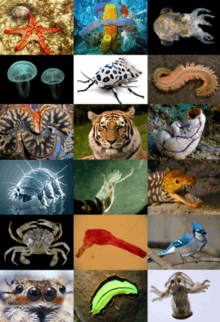Body plan

A body plan, bauplan (plural: baupläne), ground plan, ground pattern, or bodyplan, is "an assemblage of morphological features shared among many members of a phylum-level group".[1]:33
This term, usually applied to animals, envisages a "blueprint" encompassing aspects such as symmetry, segmentation and limb disposition. Body plans have historically been considered to have evolved in a flash in the Cambrian Explosion, but a more nuanced understanding of animal evolution suggests the gradual development of body plans throughout the early Palaeozoic.
Origin
It is often said that many body plans originated in the Cambrian period, in the "Cambrian explosion ".[2] However, this view is incomplete; complete body plans of many phyla, associated with the appearance of their respective crown group, did not emerge until much later in the Palaeozoic (or beyond).[3]
Genetic basis
Genes, embyros and development play a role in determining what an adult organism's body looks like.
Developmental biologists seek to understand how genes control the development of structural features through a cascade of processes in which key genes produce morphogens, chemicals that diffuse through the body to produce a gradient that acts as a position indicator for cells, turning on other genes, some of which in turn produce other morphogens. A key discovery was the existence of groups of homeobox genes, which are responsible for laying down the basic body plan in animals. The homeobox genes are remarkably conserved between species as diverse as the fruit fly and man, the basic segmented pattern of the worm or fruit fly being the origin of the segmented spine in man. The field of animal evolutionary developmental biology, which studies the genetics of morphology in detail, is now a rapidly expanding one , with many of the developmental genetic cascades, particularly in the fruit fly drosophila, now catalogued in considerable detail.[4]
Animal examples

The current range of body plans is far from exhausting the possible patterns for life:[citation needed] the Ediacaran biota is said to include body plans that are somewhat different from any found in currently living organisms, even though the overall arrangement of unrelated modern taxa is quite similar.[5]
The vertebrate body plan is one of many: most phyla (all but one, in fact) are invertebrates.
See also
- Anatomical terms of location
- Arthropod head problem
- Deep homology
- Definition of Phylum based on body plan
- Ediacaran biota
- Evolutionary developmental biology
- Homeobox
- Macroevolution
- Morphology (biology)
- Sean B. Carroll
- Supernumerary body part
- Symmetry (biology)
References
- ↑ Valentine, James W (2004-06-18). On the Origin of Phyla. ISBN 9780226845487.
- ↑ Erwin, D. H. (1999). "The Origin of Bodyplans". Integrative and Comparative Biology 39 (3): 617–629. doi:10.1093/icb/39.3.617.
- ↑ Budd, G. E.; Jensen, S. (2000). "A critical reappraisal of the fossil record of the bilaterian phyla". Biological Reviews of the Cambridge Philosophical Society 75 (2): 253–95. doi:10.1111/j.1469-185X.1999.tb00046.x. PMID 10881389.
- ↑ Arthur, Wallace. (1997). Animal Body Plans. Cambridge England: Cambridge University Press. ISBN 0-521-77928-6.
- ↑ e.g. Antcliffe, J. B.; Brasier, M. D. (2007). "Charnia and sea pens are poles apart". Journal of the Geological Society 164: 49. doi:10.1144/0016-76492006-080.